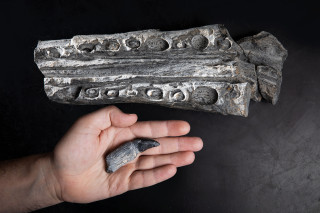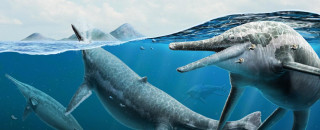Whale-Sized Marine Reptiles Gathered to Give Birth
By Randall Irmis, Chief Curator & Curator of Paleontology
In a warm, tropical sea, spiral-shaped shellfish jet past as sea lilies and corals on the seafloor wave gently in the currents. Suddenly, several 40-foot long creatures emerge in the distance, replete with large fin-like paddles and a long snout filled with sharp teeth. Any sea life that can move beats a hasty retreat as the school bus-sized predators cruise past, with a half-dozen foot-long babies in tow.

This scene might conjure up images of Hawaii or the Caribbean, but it’s actually Nevada! Long before the slot machines, silver, and sagebrush, some 230 million years ago during the Late Triassic Period much of the Great Basin was a shallow ocean just off the west coast of North America. And it was inhabited by all manner of ancient life, including these large marine reptiles called ichthyosaurs. The whale-sized creatures’ scientific name is Shonisaurus popularis; in fact, they’re so iconic that Shonisaurus is the official state fossil of Nevada. The reason for this honor is that many skeletons of this ichthyosaur species are preserved in the foothills of the Shoshone Mountains, at a place called Berlin-Ichthyosaur State Park.
Despite such notoriety, we know relatively little about Shonisaurus – what it ate, how it lived, and why so many died in one place. Fortunately, I was lucky enough to be part of a research team that endeavored to help solve this conundrum. Led by Dr. Neil Kelley of Vanderbilt University, the team just published our conclusions, and this giant ichthyosaur was even more special than we thought!
By combining clues from 3D models, geology, chemistry, and good old-fashioned inspection of fossil bones, we discovered that Shonisaurus wasn’t killed by a sudden environmental catastrophe. Rather, the skeletons accumulated gradually over hundreds of thousands of years. But there was something strange in the neighborhood – of the many dozens of Shonisaurus skeletons preserved, they either belonged to adults or newborns/embryos; we found no evidence of older juveniles. Along with other lines of evidence, this led us to conclude that Shonisaurus was gathering year after year to give birth in the same area! Such behavior might sound strange, but is observed in many living marine animals, such as whales and sharks.

©Mark Johnston/NHMU
Our team also discovered new specimens of Shonisaurus that helped clarify basic questions about its diet. Previous work suggested that this ichthyosaur might have been specialized for eating small soft-bodied prey (think squid), but our new finds included well-preserved jaws filled with large cutting teeth, indicating that Shonisaurus was specialized for eating large prey. So this marine reptile was no gentle giant, but a fearsome predator at the top of its food chain!
You can discover more about Shonisaurus and Berlin-Ichthyosaur State Park in the above video, and in this interactive story developed in collaboration with the Smithsonian Institution: https://3d.si.edu/enter-sea-dragon
This research was conducted with the permission of the U.S. Forest Service (Humboldt-Toiyabe National Forest) and Nevada State Parks.
Read more about this research in the New York Times.
Randall Irmis is the curator of paleontology and chief curator at the Natural History Museum of Utah, a part of the University of Utah in Salt Lake City. Our mission is to illuminate the natural world and the place of humans within it. In addition to housing outstanding exhibits for the public, NHMU is a research museum. Learn more.



